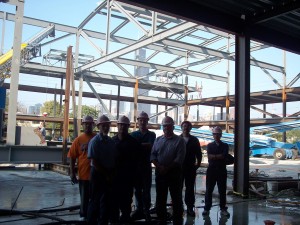One of the key principals of the Toyota Production System, that spawned such initiatives as just-in-time production and lean manufacturing, is the concept of Genchi Genbutsu which translates into “go and see.” The idea is that shop problems and process improvement opportunities should be identified and dealt with on the shop floor where the activity is taking place. How might this concept apply to Roller / Benders, metal bending companies that specialize in curving metal?
First of all, the concept directly applies to the production of OEM parts in the Bender/Roller shops. All those involved directly or indirectly in the process–including project managers, engineers, purchasing agents, and even sales persons–may need to meet on the shop floor to “go and see” how best to proceed.
In our shop recently, a machine operator was given the task of putting some twelve bends with three orientations in a steel plate. A template was provided but with no information on the radii or arc lengths involved. Had the project manager provided the machine operator with the mid-ordinate rise over defined segments of the curved tube, the operator would have had an easier time. The part turned out fine, but the process could have been better. It was only when the project manager decided to go and see the process that the problem and solution were identified.
How might this apply in the case of curved steel for the construction industry? Another way of expressing the “go and see” concept is by the Japanese word “Gemba” which translates roughly to mean “the real place.” In steel fabrication, the Gemba is the factory floor where value is created. Management should go to the front lines to identify waste and opportunities. For example, if management sees forklifts moving raw material, work in process and finished goods within the factory in ways that add no value, management should work with shop personnel to move equipment to minimize flow time and flow distance in the fabrication process.
When Bender/Rollers produce OEM parts as well as curved steel members for construction, the Gemba, the real place, can also be the shop floor of the OEM customer or the shop floor of the steel fabricator. Visits by Bender/Rollers to their customers and vice versa can add great value through increased communication especially when identifying expectations.
Finally, the concepts of “go and see” and “the real place” can be extended to include the sales floor and construction site where Bender/Rollers can interact with the final customer as well as all the intermediaries in between.

Genchi Genbutsu is pronounced “gen” as in “again” + chee, and then “gen” again with “but” as in “boot” and “su” as in “sue”. Mimicking the sound and sense of the Japanese word, the concept has sometimes been loosely translated as “Getcha your boots on.” So lace them up and go and see the real place.







